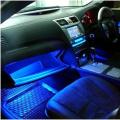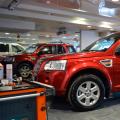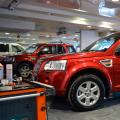Autumn has come. Winter is ahead. The days are short. Rains, snow, fog further impair visibility. People's clothing has become faded and cars are often dirty. Driving has become more difficult. In conditions of insufficient visibility, the car must be clearly visible to participants road traffic... And they are for the driver. The driver must also see the road and possible obstacles on it. All this is served by numerous lighting devices car. The main thing, of course, is the headlights, which I have already written about. Next in importance - parking lights and brake lights. Now it is almost impossible to drive without turn signals, although the Rules still provide for giving these signals by hand, and even during the day, hardly anyone will pay attention to them. Many cars have and fog lights and lanterns. And they help not only in the fog. About fog lights, their design features and not everyone knows effective use. Even the drivers. How are they different from other types of headlights? And when should they be turned on? The biggest misconception is that these headlights should have yellow glass. Indeed, the rules say that fog lights must have yellow or white... And that's all. And many believe that yellow light better "breaks through" the fog. But this is not the case. There is no difference. Fog lights from reputable automotive lighting manufacturers are white. For fog lamps, the main thing is not the color, but the distribution of the light flux. They give a flat and wide horizontal beam that spreads directly over the road so as not to illuminate the thickness of the fog in height. Often, the fog does not reach directly to the ground. it occurs under conditions when the earth is warmer than air. Correctly adjusted headlights shine not far - about ten meters. More is not necessary - the speed in the fog is small. But they also shine to the sides - it is necessary to see the roadside and marking lines in case of poor visibility. Some cars also have a red fog light in the back. It shines brighter than side lights and even brake signals. The taillight should burn in the fog both day and night. This will allow the driver behind you to see you in the fog earlier. During the day, in the fog, instead of the fog lamps, you need to turn on the main beam of the main - not for lighting - there is enough light, but so that oncoming drivers can see you. Fog lights are useful without fog too. Previously, they were recommended to be turned on in the dark on narrow roads with a lot of bends. The speed is small, but they shine sideways. Now, on some cars, the headlights turn to follow the steering wheel. But even when driving straight, it is useful to shine sideways on narrow forest roads, and when driving through yards crowded with cars - an animal or a person may appear. In such cases, I usually turn on the fog lights and the low beam of the main ones at the same time - it shines a little further. Use your lights correctly and your ride will become even safer.
Operating principle
Fog is a suspension of fine water droplets in the air. When the road is illuminated with main headlights in fog, the light beam is scattered, partially reflected from the drops, blinding the driver and significantly impairing visibility. This effect is most noticeable in the short-wavelength part of the spectrum corresponding to blue... When the road is illuminated with a lamp behind red and yellow light filters, the reflection effect is reduced, visibility becomes better.
Airborne suspension, which is called fog, tends to hang over the surface of paved roads at a certain distance. Therefore, the light of low-mounted headlights is subject to the effect of light reflection from water droplets to a lesser extent - the headlights in this case shine “under fog”. Rain and snowfall do not have this property. In this case, it is the color balance of the light emitted by the headlights that is important.
Based on this, additional fog lights are installed on cars. They provide a sharply directed light flux at a height of about half a meter from the road surface and are equipped with yellow light filters.
Installing fog lights
Traffic rules stipulate that fog lights should be installed on a car only in pairs (two headlights) at a distance of no more than 400 mm from the side dimension plane along the outer edge of the headlamp lens and no more than 250 mm from the level road surface on the lower edge of the diffuser. Fog lights should not be installed higher than the dipped beam headlights (that is, on modern cars higher than the main headlights), except four-wheel drive vehicles high cross-country abilityon which the headlights can be installed higher (for example, on a roof or a special bracket) to ensure their safety. Vertical permissible angle lighting of fog lights from +15 to -10 degrees. Horizontal - from +45 to -10 degrees. The fog lights come on only when the side lights are on.
Fog lights are standard or optional on many models modern cars... Sometimes they are integrated into the main headlight unit under a common lens. In this case, the fog lamp is located below the main lamp. If the fog lights are installed separately in basic or optional equipment, they are usually located in the front bumper.
When self installation fog lights or when installed in a workshop, ensure that the headlights are securely attached and correctly connected to the vehicle's electrical network.
Use of fog lights

When operating a car equipped with additional or complete fog lights, it should be borne in mind that they do not replace the dipped beam mode of the main headlights, since they have a shorter illumination range. On the other hand, the use of fog lights with the main headlights off in moderately limited lighting conditions (with the parking lights on at dusk, on illuminated city streets) improve the perception of the road, make the car more noticeable in traffic, and at the same time, the fog lights do not blind the drivers of oncoming vehicles.
In heavy rain and snow, fog lights are not able to significantly improve road visibility. They have a limited effect, so the driver should not overestimate their capabilities.
When installing the fog lamps yourself, remember that it is too high installed headlights do not improve, but worsen the illumination of the road in fog conditions, since they increase the luminous flux reflected from the airborne suspension. When choosing fog lights for installation on a car, you should give preference to headlights with a yellow glow - as the most effective.
Fog lamp markings
Fog lights certified for use on the territory of Russia must have the “E22” badge in their marking and designation of the category of the light source. For fog lamps, this is category "B" (Latin letter). As additional information we give the notation car headlights other categories.
FROM - the dipped beam headlamp (if it is made as a separate light device).
R - headlight high beam (if it is made as a separate lighting device).
H - headlight with halogen bulb only.
PL - lamp with a diffuser made of optical plastic.
S - glass block headlight.
Fog lights designed for installation on cars with "right-hand drive" (and, accordingly, for use on roads with left-hand traffic) are prohibited in Russia. In any case, the light of "right-hand drive" cars should be adjusted for driving on roads with right-hand traffic. This also applies to fog lamps - if they enter basic configuration imported car.
All drivers will probably be very interested in what bulbs are installed in the fog lights. After all, these elements are very important in the car, thanks to them it is possible to move safely in difficult weather conditions, such as snowfall, rain, fog. It would seem that there are ordinary headlights, why else are there foglights? We'll talk about all this below.
Fog lights - what is the special feature of the radiation?
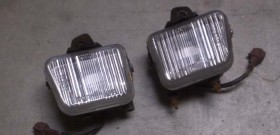

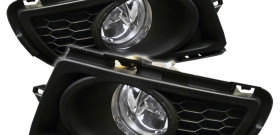
What is behind the fog lamp glass?
The device of fog lights is practically the same as for conventional headlights: body, paraboloid reflector, light source and diffuser. In order for the visibility to be good during rain or fog, the upper boundary of the beam must be clear, which means that neither the light from the lamp itself, nor the reflected beam must go above the horizontal plane. And to ensure good lighting of the road surface, they should be placed as close to the road as possible, but not lower than 25 centimeters above the ground.
This is also influenced by nature itself. After all, the fog spreads not along the ground itself, but a little higher.
The first reflectors were round in shape, but later ellipsoidal were proposed, the fact is that such reflectors have two focuses at once. In a parabolic reflector, the light source is located at the focal point, because of this, the reflector directs the beam along the central axis, and the diffuser, in turn, expands this beam, thereby forming a horizontal stripe. A special screen prevents the beam from projecting upward. So we got an optimal lighting device for foggy conditions.
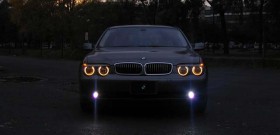
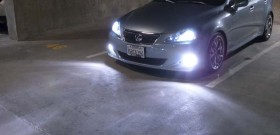
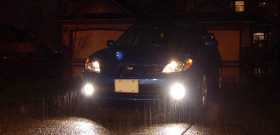
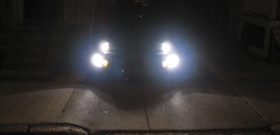
Fog light button and smart light mode
Lamps in fog lights are installed both and halogen. It is impossible to unequivocally answer which of them is better, since the former shine brighter, but because of this they can blind other drivers. And if you installed them personally, and they were not provided for by the design of the car, then it is quite possible that you may have problems with the traffic police. The device itself provides all the necessary elements, fuses and relays, in addition, you may only need a button for the fog lights, for their short-term activation, and control indicators of operation.
Using the short-term activation button, you can give someone a prearranged signal and "blink" with foglights, this is often practiced among drivers in order to warn each other about a traffic police post. In order to protect himself from an accident, the traffic rules say that the driver must indicate his vehicle while driving at any time of the day. This can be done with the help of low beam headlights, or - daytime running lights. It is possible to use fog lights in DRL mode (daytime running lights).
By connecting the fog lamp relay to the necessary connectors, we get the following: when the engine is started, they turn on in DRL mode, but as soon as you turn on the dimensions, they immediately go out. If you need to turn them back on, then you need to turn the standard switch. This is a fairly convenient and necessary function, especially considering new traffic rules... This way, you don't always have to remember that every time you go out in the car, you need to turn on something that you are not yet used to at all.
To operate the car in poor visibility conditions, you must use special devices - fog lights or lamps. Read about what a fog lamp is, what types it is, how it works and how it works, and how to choose the right headlight for a car - read in this article.
What is a fog lamp?
(PTF) - a special automotive lighting device designed to improve road illumination in poor visibility conditions. This headlamp is used to improve road visibility and vehicle in fog, heavy rain, snow, dust storm, etc.
PTF improves traffic safety on all types of roads in the most difficult climatic conditionstherefore, car owners often install it on their own initiative. But before choosing and installing a fog lamp, you need to understand the existing types of these devices, their designs and operating features.
Types and design of fog lights
Fog lights can be divided into groups according to their purpose and spectral composition of the emitted light.
By appointment, foglights are:
- Front - to illuminate the road in front of the car, installed in the front of the vehicle;
- Rear - to improve the visibility of the vehicle, installed in the rear of the vehicle.
Lighting devices installed in the front of a car are usually called fog lights, as they are designed to improve the illumination characteristics of the roadway and improve visibility for the driver of this vehicle. These devices perform the same functions as the head light, but in poor visibility conditions.
The device installed in the rear of the car is usually called a fog lamp, since its main purpose is to improve the visibility of the vehicle itself to drivers of cars moving behind. These devices perform the same functions as the taillights, but in poor visibility conditions.
According to the spectral composition of light, fog lights and lamps are:
- White - equipped with an ordinary transparent diffuser;
- Yellow - equipped with a yellow diffuser;
- Red - only rear lights, equipped with a red diffuser.
We especially note that pTF color does not affect the quality of road lighting during fog, but it does affect the driver's perception of the road situation. The use of yellow headlights (or rather, selective yellow, in which the blue part of the spectrum is significantly weakened) is due to the physiological characteristics of our visual apparatus. The human eye is most susceptible to the yellow-green part of the spectrum, therefore, objects in yellow and objects illuminated yellow light, we perceive faster, better and clearer than others. Therefore, in the light of the yellow fog lamp, objects will appear more contrasting, which in some cases increases safety.
However, the principle of operation of the PTF is not in the color of its diffuser, but in the direction and shape of the light beam, and the features of the installation. Fog lights have two key features:
Light beam formation
- Formation of a light beam directed directly above the road surface - the beam has a clear upper boundary and is directed forward and downward;
- Installation not high above the road surface, thereby achieving illumination of the canvas under a layer of fog.
Thus, the fog light does not shine into the fog itself, but directly onto the roadway. The formation of a directional light beam prevents unnecessary scattering of light in fog (on snowflakes, drops or dust particles), which improves the visibility of the road and the traffic situation.
Structurally, PTF and lights are similar to low beam headlights. They are based on a housing, inside which is a reflector (reflector) with a lamp (or LED emitter), and covered with a transparent diffuser. To provide a directed light flux with a clear upper boundary, a reflector of a certain shape is used, and the lamp is installed not at the very focus of the reflector, but with some displacement. With this design, the light from the lamp is reflected from the top of the reflector forward and downward, so the light beam spreads over the road.
In this case, fog lights and lights can be of two types:
- Hull - they are designed in their own case, can be installed on various vehicles, including those that were not equipped with this type of lights;
- Unpackaged (built-in) - have a shape and configuration for installation in regular places provided in the vehicle design.
Regardless of the type, all fog lights and lamps are manufactured and installed on vehicles in accordance with applicable government standards.
GOSTs and questions of the use of fog lights
In our country, there are a number of norms governing the production, installation and operation of fog lamps and lamps, the main ones are two documents - GOST 8769-75 and GOST R 41.48-2004 (EEC Rules No. 48).
According to these standards, fog lights are installed in the following cases:
- On cars and trucks - optional (at the request of the vehicle owner);
- On tourist and mountain buses - obligatory;
- On trailers - the use of fog lights is prohibited.
The number of PTFs is two, they are located in the front of the car, at a height of at least 250 and no more than 800 mm from the roadway, and no more than 400 mm from the extreme dimensions of the car. Moreover, the fog lights must be located below the dipped beam headlights. Color - white or yellow, but the same for both headlights.
The inclusion of fog lights should be independent of the inclusion of dipped and main beam headlights, they can function as a head light in poor visibility conditions.
The rear fog lamp is installed in the following cases:
- On vehicles issued before January 1, 1991 - their absence is allowed, if this is not provided for by the project;
- On vehicles manufactured after January 1, 1991, the presence of a rear fog lamp is mandatory;
- On wheeled tractors - installation is optional.
The number of lights - one or two, they are located on the rear of the vehicle at a height of at least 250 and no more than one meter above the level of the road surface, and not less than 100 mm from the stop signal. If there is only one lantern, then it must be placed on the left side. For off-road vehicles, the installation of fog lights at a height of up to 1200 mm is allowed. The diffuser color is red. The lamp must be switched on together with the front foglights, and their parallel inclusion with stoplights is strictly prohibited.
According to the current traffic rules (clause 19.4 of the RF SDA), PTFs can only be switched on in conditions of insufficient visibility and at night, together with the main head light, in the daytime they can act as daytime running lights. And the rear fog lights, according to clause 19.7, can only be switched on in case of insufficient visibility (fog, snow, dust storm), and administrative punishment follows for connecting this device to the stoplights.
How to choose a fog light?
When buying PTF and lanterns, you must take into account the make and model of the car, its design features, as well as the supply voltage of the on-board network.
If the car is provided with the installation of fog lights or rear lights, then you need to buy those devices that are recommended by the vehicle manufacturer. If this is your first time installing headlights, then you should choose those devices that are suitable in size and supply voltage. Additionally, you will have to take care of the purchase of wires, relays, fuses, etc.
When choosing fog lights, you need to pay attention to their marking - given type headlights are marked with the letter B, so it is easy to distinguish it from others. You should also give preference to those lighting devices that comply with the current GOST (which, again, is evidenced by the marking), otherwise the headlights will not only be useless, but also dangerous.
When installing and adjusting fog lights, the above standards must be observed, otherwise the vehicle may not pass the inspection.
Fog lights are easy to adjust. It is necessary to park the car at a distance of 7.6-8 meters from the vertical surface (screen), and ensure that the upper border of the light beam from the headlights is 10 cm below the center of the headlights. Only in this case will normal illumination of the roadway be ensured in conditions of insufficient visibility.
When the right choice and the installation of fog lights and lamps, you will be prepared for all weather conditions.
Most drivers are probably interested in the question of what fog lights are, what they are and how they differ from ordinary headlights. The peculiarity lies in the lamps that are installed in such lamps. Each of these elements is of tremendous importance, since it is thanks to the light emanating from them that the driver can safely drive in bad weather conditions, for example, in fog, during rain and snow. It may seem that fog lights are not needed, as there are conventional ones. But no.
Fog lamp device
In bad weather conditions, the beams emitted by conventional high or low beam headlamps are reflected from water droplets and scattered. Due to this, a translucent film is obtained, which interferes with good visibility. Fog lights distribute light in a completely different way. Since such lights are installed close enough to the roadway, the light seems to go under the fog, which never "falls" directly on the road, and the beam of light is strictly horizontal.
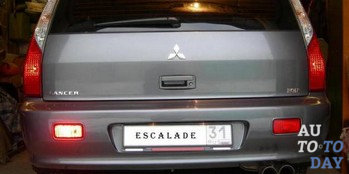 They will also help you when driving on winding roads, as they provide good illumination of the roadside, thanks to which you will successfully maneuver. There can be both white and yellow glass on the foglights, but there is no fundamental difference. Particular attention should be paid to the quality and the manufacturer of the bulbs. Today, there are headlights that have a corner lighting function when the steering wheel is turned a certain radius, or when the turn is turned on, the headlight from that side also starts to glow.
They will also help you when driving on winding roads, as they provide good illumination of the roadside, thanks to which you will successfully maneuver. There can be both white and yellow glass on the foglights, but there is no fundamental difference. Particular attention should be paid to the quality and the manufacturer of the bulbs. Today, there are headlights that have a corner lighting function when the steering wheel is turned a certain radius, or when the turn is turned on, the headlight from that side also starts to glow.
Fog lights should be installed symmetrically, always below the main headlights, or at their level at a distance of no more than 25 cm from the road and no more than 40 cm from the side dimensions. Turning on the fog lights can only be done while driving along with the dimensions.
Fog lights are designed in a similar way to conventional headlights: they have a body, a parabolic reflector, a diffuser and a light source. In order to be clearly visible in foggy or rainy weather, it is necessary that the upper limit of the light beam is clear enough, that is, neither the lamp's light nor the reflected rays should go above the horizontal plane.
Fog lights are of several types: round, oval, square, rectangular. More recently, such headlights have appeared that work on wind energy. Moreover, they do not require a mains supply. They also have several other advantages - they are beautiful in design, versatile, as they fit any transport, they have a bright light indicator, they are painted with waterproof paint.
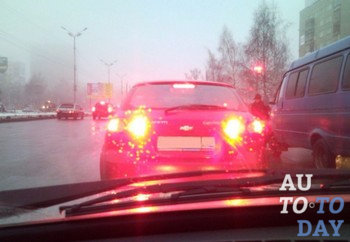 The fog lights are equipped with xenon or halogen lamps. Each set of lamps is equipped with all the necessary components: fuses, relays. Installation will also require a power button and indicator lights.
The fog lights are equipped with xenon or halogen lamps. Each set of lamps is equipped with all the necessary components: fuses, relays. Installation will also require a power button and indicator lights.
Rear fog lamps have several advantages. Thanks to them, your car will be visible even in the worst weather. Thus, every driver who is following you will have time to brake in time if necessary.
Installation of rear fog lamps
Fog lights are installed in the rear bumper on the standard car wiring. First you need to purchase fog lights that satisfy all technical requirements... When choosing, you need to consult a specialist about which lights are suitable for your car. You should also decide on the characteristics. This choice is individual. Fog lights can be installed in place of regular headlights.
Before proceeding with the installation, the entire system must be checked to ensure that it functions normally. In order to install, you need the following kit:
- steering column switch with a switch;
Two waterproof terminals;
Set of tools.
Remove the rear bumper by unscrewing a pair of self-tapping screws and 10 bolts along with the five pistons at the bottom. The standard reflectors are fixed quite simply, so there should be no problems with their dismantling. But this is the end of the work with the bumper.
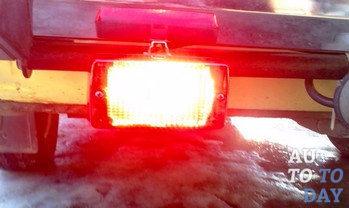 After that, the most difficult stage is disassembling the steering column. Remove the plugs on the side of the steering wheel, unscrew a couple of "stars" and take out the pillow. Unscrew the steering wheel, loosely loosen it, after which it should come off. You need to be very careful with this, as you can tear the cushion wire when removing the steering wheel. Dismantling the mount must start from the bottom.
After that, the most difficult stage is disassembling the steering column. Remove the plugs on the side of the steering wheel, unscrew a couple of "stars" and take out the pillow. Unscrew the steering wheel, loosely loosen it, after which it should come off. You need to be very careful with this, as you can tear the cushion wire when removing the steering wheel. Dismantling the mount must start from the bottom.
Further, almost all elements will be fastened with latches, their dismantling should not cause difficulties. Only it will be necessary, using pliers, to squeeze the elastic ring that fixes the steering column switches. Assembly is performed upside-down.
Frequent faults of rear fog lamps
The breakdown of foglights is a violation of their correct operation. You can detect such changes by using diagnostic system cars. Thanks to it, you can determine the problems and their causes: changes associated directly with the reference voltage of 12V, that is, with the switch.
Some problems may occur due to the signal from the combined light switch. Serious problems may arise with the control of the fog lamp relay and their mass. It so happens that the fog lights simply do not work or do not turn off. How is the circuitry of this system constructed? A signal is sent to the body equipment control unit (BMC), which comes from the fog light switch. The switch is part of the headlight switch assembly.
The voltage to the switch comes from the BCM unit. All signals go through the 12V reference circuit. When you press the switch, a voltage short occurs from the voltage reference circuit. This happens due to the resistor pressure on the ground in the switch itself. This is the essence of the resistor chain.
The functional purpose of this chain is to provide a signal for dimming the light. Voltage is supplied to the BCM unit via the signal chain of the switch. What problems can arise on the relay? It makes sense to remind you that it is through this node that the battery power is supplied.
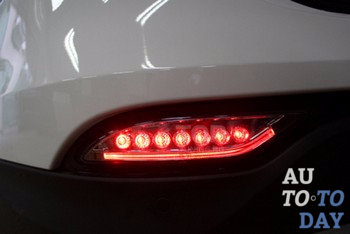 Since the connection of the signal circuit of the fog light switch with ground through a resistor is rather short-term, then the switch is pressed at this time. The fog lamp relay is "powered" from the BCM unit, that is, the fog lamp relay control circuit is shorted to ground. When voltage comes to the relay, its contacts are closed. Voltage from battery goes to the fog light control circuit through several fuses. It turns out that they are activated. The system needs to be checked like this:
Since the connection of the signal circuit of the fog light switch with ground through a resistor is rather short-term, then the switch is pressed at this time. The fog lamp relay is "powered" from the BCM unit, that is, the fog lamp relay control circuit is shorted to ground. When voltage comes to the relay, its contacts are closed. Voltage from battery goes to the fog light control circuit through several fuses. It turns out that they are activated. The system needs to be checked like this:
1) Turn on the headlights and ignition. Then use the scan tool to look at the Fog Light Switch parameter. A task this parameter - turn on or off the fog lamp switch itself. It must sequentially take the value "Active" / "Inactive". If the switch does not occur, then the system has problems.
2) After identifying the problem using the same diagnostic tool, you must first issue a command to turn on and then turn off the foglights. Remember that these items turn on and off after changing these states. If the foglights do not start to light up and go out, then the problem needs to be solved by specialists.
Fog lights can be tricky to maintain, but they do their job well - helping to keep you alive.
Subscribe to our feeds in

